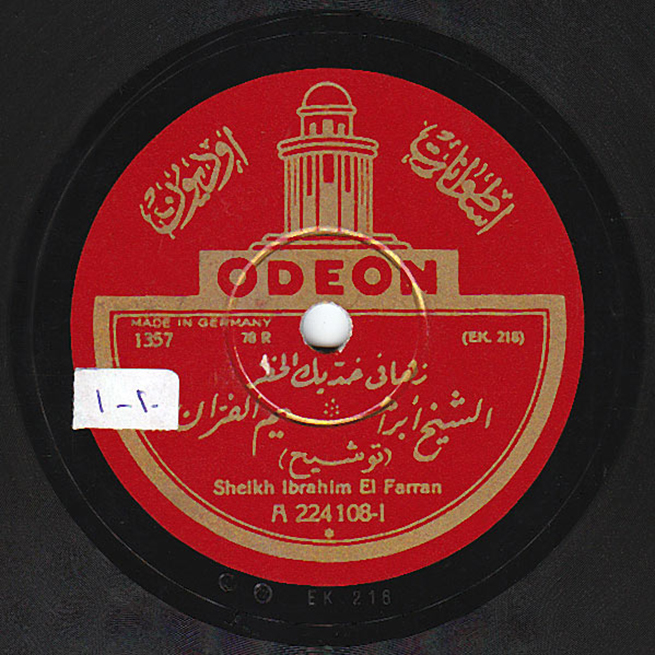Images
All images are courtesy of AMAR Foundation

search

All images are courtesy of AMAR Foundation

The ‘ushshāq maqām
The Arab Music Archiving and Research foundation (AMAR), in collaboration with the Sharjah Art Foundation (SAF), presents Niẓāmunā al-mūsīqī.
The ‘ushshāq maqām — derived from the dūkāh — is ranked as the fifth maqām and thus was called banjkāh before the Persians and the Iraqis gave this appellation to a rāst sub-maqām. Some specific traditions in the Ḥijāz region still use the banjkāh appellation, i.e. fifth maqām, for the ‘ushshāq maqām.
It was derived from the dūkāh through the alteration of the sīkāh burj and replacing it with the būslīk. Its pattern as well as all its sub-maqām resemble the bayyātī’s, if we take this replacement into consideration.
The Arabs’ ‘ushshāq maqām is completely different from the Turks’: in the Turkish tradition, the ‘ushshāq is a dūkāh sub-maqām with a scale order resembling the bayyātī’s, but with a different pattern.
Mustafa Said speaks of the nature and pattern of the sīkāh maqām saying:
The ‘ushshāq is ranked as the fifth type, aspect, or maqām, within the seven original maqām.
According to mashāyikh, it is derived from the bayyātī, i.e. the bayyātī was originally: … ♩
Then the ‘ushshāq was derived from it, and it became: … ♩
And it resumes its scale order to the bayyātī: … ♩
Its pattern resembles the khanabāt in the Iraqi maqām waṣla, and has an equivalent in Persia as well as in Turkey where it is called ‘ushshāq ‘arabī or būslīk. But this is not the subject of our discussion.
Numerous sub-maqām are derived from the ‘ushshāq, including the nahāwand considered as an original maqām. Consequently, the ‘ushshāq type or aspect started being referred to as a nahāwand aspect, or a nahāwand jins, whereas the ‘ushshāq is the original maqām and the nahāwand is derived from it. The sub-patterns include the faraḥ fazā, the ḥiṣār (that is also a ‘ushshāq sub-maqām) … ♩
In Turkey, it is called Egyptian ‘ushshāq because the Turkish ‘ushshāq is derived from the dūkāh, like the bayyātī, while the Egyptian ‘ushshāq or ‘ushshāq ‘arabī is the original maqām from which the nahāwand, among other sub-maqām, was derived. We will discuss this point later on.
The ‘ushshāq pattern is as follows: … ♩
The second and the third scale-steps are close … ♩
The note is not complete … ♩
It is missing a tone … ♩ (a short 9/10 tone instead of a complete 8/9 tone)
Then it goes to the bayyātī … ♩ at the ḥusaynī
Or produces another ‘ushshāq aspect at the nawā … ♩
A kawasht (short aspect) can be played here … ♩
The ‘ushshāq maqām is originally derived from the dūkāh, still it can be played based on the rāst, the ‘ushayrān, the yakāh, or any other scale. The taṣwīr of the maqām bears no relation to its aspect.
Let us listen first to a taqsīm on the qānūn played by Muḥammad al-‘Aqqād to the ‘ushshāq maqām, starting with a taqsīm mursal followed by a taqsīm ‘ala al-waḥda. The recording was made in 1930 by Gramophone on two sides of a 25cm electrical-power printed record. This is an unpublished record — sample record —, matrix # BG488 and BG489.
(♩)
It is easy to compose a tune and to improvise with the melodious and pure ‘ushshāq.
Let us listen to an example of a fixed tune then of an improvised one. Here is Sheikh Sayyid al-Ṣaftī singing muwashshaḥ Ta‘āla yā khayāl then mawwāl Yā mālik el-rūḥ. The recording was made in 1907 by Gramophone on two sides of a 25cm record, order # G.C.-15-12448 and G.C.-15-12449, matrix # 9149b and 9150b.
(♩)
One of the most famous dawr composed to the ‘ushshāq maqām is dawr Shribt el-ṣabr written and composed by ‘Abduh al-Ḥāmūlī after dawr Shribt el-rāḥ written by Al-Ḥāmūlī as a eulogy to his son who died on his wedding day. Let us listen to Riyāḍ al-Sunbāṭī singing this dawr performed during a private jalsa in the 1960’s.
(♩)
The numerous ‘ushshāq sub-maqām include the famous nahāwand, faraḥ fazā, ḥiṣār, nawā athar, būslīk, muraṣṣa‘ …etc.
Let us now listen to Sheikh Ibrāhīm al-Farrān singing tawshīḥ Zahā fī khaddayk al-khafar to the ḥiṣār sub-maqām. The recording was made by Odeon on two sides of a 25cm electrical-power printed record, order # A224108, I and II, matrix # EK 218 and EK 219.
(♩)
We have reached the end of today’s episode of Niẓāmunā al-Mūsīqī.
We will meet again in a new episode.